SEC OF





The National Security Agen cy designated LSU as a National Center of Academic Excellence in Cyber Operations (CAE-CO), making LSU one of 22 universi ties in the country to receive the recognition.
Computer science professor Golden Richard was at a former CAE-CO school before coming to LSU in 2017. He did most of the work to receive LSU’s designation in collaboration with Greg Trahan in the Office of Research and Eco nomic Development.
According to Richard, the NSA has different designations in cy bersecurity, and the designation LSU received in cyber operations is the most prestigious and diffi cult one to earn.
To receive the designation, LSU had to meet certain standards set by the NSA, including having certain classes taught within the program. For example, Richard said the university has to have a reverse engineering class as well as courses in computer viruses and cryptography.
“A few of those classes are re ally the sticking point [because] most universities simply don’t have someone that can or will teach some of those topics,” Rich ard said.
As part of [President William Tate’s] cybersecurity initiatives, computer science professors Ibra ham Baggili and Aisha Ali-Gombe were recruited to LSU’s faculty.
The cybersecurity program is a concentration within the Com puter Science Department at LSU. The program began in 2020 with around 19 students, but Richard said it has now grown to over 100 students, and Baggili and AliGombe will be “instrumental” in keeping up with the growing en rollment numbers.

The designation will also show on students’ transcripts, which can be notable when applying for jobs after graduation.
“[There’s] the knowledge that the curriculum and the program that you’ve gone through as a student is valuable by the agency that’s probably doing the most important cybersecurity in the world,” Richard said.
Computer science senior Kar ley Waguespack chose to study cybersecurity after seeing the support she could receive within the program. She’s enjoyed the concentration so much that after she graduates in the spring, she plans to stay at LSU for graduate school.
“The program has been grow ing so much. I know that it’s prob ably going to be one of the best places that I could possibly be at right now,” Waguespack said.
Waguespack has been able to witness the cybersecurity pro gram grow over the past few years.


“Whenever I started out, we didn’t have as many classes and resources, and I’m kind of see ing firsthand how the program is growing and evolving over time. Just this past year, we’ve gotten so many new cybersecurity facul ty and classes,” Waguespack said.
She believes the NSA designa tion is attracting more faculty and students to LSU, which enables the university to receive more re sources to improve the program. She expects there to also be more collaboration between LSU and corporations looking for cyberse curity graduates.
Waguespack is excited to see the changes the designation will bring, including the new cyberse curity classes that will be added next semester.
“Cybersecurity faculty are still hard to come by. A lot of schools don’t really get to have these classes. So I feel really lucky that I can take classes like this…I’m really excited about the direction that [the program] is going in,” Waguespack said.
Baggili, one of the new com puter science professors, current ly teaches a research topics class in cybersecurity and forensics and will teach a digital forensics course in the spring. Before com ing to LSU, he was part of the faculty at the CAE-CO designated Connecticut Institute of Technol ogy at the University of New Ha ven.
Baggili came to LSU for a vari ety of reasons, including to work
with the “world-class faculty” in the Computer Science Depart ment as well as President Tates’ scholarship-first initiative. He be lieves the new designation will have a positive impact on LSU’s cybersecurity program.
“The best way to describe it is that [LSU] is the SEC of cyberse curity. I joke around and say we put the SEC in cyberSEC,” Bag gili said. “The students will now know that they are by far at the top program in Louisiana, since it’s the only designated program in the state.”
Baggili said that students will benefit from the new designation as they now have more research funding opportunities and access to elite internships.
“How amazing it is to have ac cess to the opportunities through a program like this, at an afford able education. Other programs of this caliber are typically avail able at private universities, where tuition can cost upwards of $70,000 a year,” he said.
Ali-Gombe, who also recently joined LSU’s faculty, currently teaches a class on operating sys tems and will teach a reverse en gineering and malware course in the spring.
Ali-Gombe came to LSU from Towson University, a CAE-COcertified school in Maryland. Pre viously she was a postdoctoral student at LSU in 2017 and main tained a position as a visiting re search scientist, and has returned to LSU to be a part of the growing
cybersecurity program.
“When this cybersecurity ini tiative started, I felt like this [was] really the time to be here…I think I can contribute something to this program because of the experi ence of having taught in a CAECO school,” Ali-Gombe said.
She said that to be designated, the program had to go through a long and rigorous process of sub mitting its curriculum, which is vetted by the NSA. While it was an intensive task, Ali-Gombe said she believes the designation could be a potential deciding fac tor for incoming freshmen.
“Instead of you going to [other universities], you should come to LSU, because they’re providing this content of this curriculum, probably even cheaper,” AliGombe said.
She also said that faculty will now have access to research funds only available to designat ed schools, which could lead to purchasing better equipment and hiring more students to work in the research labs.
By preparing students to be experts in cybersecurity, AliGombe believes the university can fill jobs in the rapidly grow ing industry.
“[President Tate] wants to see LSU as the top cybersecurity school in the nation – I want the same thing. I want to be part of that, I want us to give our stu dents the best, nothing less than that,” she said. “LSU is going to make a name in cybersecurity.”
HANNAH MICHEL HANKS JAYDEN NGUYEN BELLA DARDANO DOMENIC PURDY
An article published in the Oct. 3rd edition stated that there was a vote at the Wednesday, Sept. 28 meeting to put a referendum before the student body in the fall election to raise the SG fee, which would increase the student media budget; however, the vote was not yet conducted.
The Reveille is written, edited and produced solely by students of Louisiana State University. The Reveille is an independent entity of the Office of Student Media within the Manship School of Mass Communication. A single issue of The Reveille is free from multiple sites on campus and about 25 sites off campus. To obtain additional copies, please visit the Office of Student Media in B-39 Hodges Hall or email studentmedia@ lsu.edu. The Reveille is published biweekly during the fall, spring and summer semesters, except during holidays and final exams. The Reveille is funded through LSU students’ payments of the Student Media fee.
Several campus organizations are partaking in initiatives to raise awareness and promote civ ic engagement ahead of the Nov. 8 midterm elections.
Various organizations are hosting voter registration drives to ensure that as many eligible students and faculty members are registered and have a plan to vote on election day.
Nonpartisan organization Geaux Vote has already hosted voter registration events on cam pus. For National Voter Registra tion Day on Sept. 20, students from Geaux Vote set up in Free Speech Alley to register potential voters as they passed by.

From 10 a.m. to 3 p.m., mem bers of Geaux Vote assisted pass ersby with questions or difficul ties they had while navigating the registration process.
Mass communication senior Bridget Cotten, president of Geaux Vote, said that as the elec tion comes closer, Geaux Vote plans to register more voters and notify voters of important elec tion deadlines using their social media platforms.
She said that the organization is emphasizing voter registration deadlines and election informa tion to out-of-state students who might not have easily accessible information about their state’s elections, specifically reminding them to return absentee and mailin ballots. Louisiana residents are also notified of the Oct. 11 dead line for in-person registration, and the Oct. 18 deadline for on line registration.
“If they are interested in reg istering to vote, we help them through the process,” Cotten said.
“A lot of people can get swept up in it and just forget that you’ve got to vote.”
International trade and fi nance junior Cooper Ferguson, president of College Democrats of LSU, said that College Demo crats is “hyper-fixated on the mid terms.”
College Democrats is hosting events around campus to promote civic engagement and inform stu dent-voters about measures and candidates on the ballot. The or ganization also has plans for a forum with U.S. Senate candidate Gary Chambers.
In addition to forums, College
Democrats hosted question and answer sessions with candidates, voter registration drives and com munity involvement projects to inform students on campus about the election.
“It’s a pretty nonpartisan but
LSU and 115 schools around the country are partnering with Hilin ski’s Hope Foundation from Oct. 1 to Oct. 8 for its third annual Col lege Football Mental Health Week, according to a press release.
Hilinski’s Hope Foundation was founded by Mark and Kym Hilinski in 2018 to honor their son Tyler, a Washington State quarterback who took his own life in 2018 and suf fered from the lasting effects of chronic traumatic encephalopathy (CTE). The week will honor Ty ler, those lost, and those suffering from mental health issues, accord ing to the press release.
Kym Hilinski, Tyler Hilinski’s mother and co-founder of Hilin ski’s Hope Foundation, said in the press release that while conversa tions around mental illness can be tough and uncomfortable, they are critical for the well-being of stu dent-athletes.
She also said that Hilinski’s Hope helps colleges and universi ties save lives, eliminate stigma and scale mental wellness programs for student-athletes by connecting stu dents with mental health resources and assisting universities with in stitutionalizing the best practices.
Even though the first week of October is Mental Illness Aware ness Week, the LSU Student Health Center and LSU Athletics will con tinue to maintain their focus on mental health for student athletes.
Raime Thibodeaux, director of Mental Health at the Student Health Center, is an advocate for
An LSU biologist, in coopera tion with NASA, has been inves tigating how plants adapt to toxic soils with high amounts of saline in them, similar to the soil condi tions found on Mars.
Maheshi Dassanayake, an as sociate professor of biological sci ence, said she and her team cur rently have a number of candidate genes that will be contributors to plants to help them survive in the harsh environmental conditions of Mars. They are currently introduc ing these genes to crops in order to test whether the crops could be grown in these Martian habitats.
Dassanayake said she became
interested in attempting this proj ect because she said, “we cannot envision long-term human habitats without plants on Mars.”
Right now, there are no plants on Earth that can survive the harsh conditions on Mars.
“As plant biologists, we are in terested in contributing to human exploration beyond our planet,” said Dassanayake.
Dassanayake is working with Scott Perl, a research scientist spe cializing in life in extreme envi ronments at NASA’s Jet Propulsion Laboratory, on the project.
A challenge Dassanayake has come across in her research has been conducting plant growth tests on Martian soil in order to under stand the challenges the soil will
present. This data, she said, is cur rently unavailable and the studies still remain at the planning stage.
The specific issue with Mar tian soil, Dassanayake said, is its generally high saline content and unspecified amount of water, ni trogen and phosphorus, which can lead to malnutrition. The high lev els of saline often impact negative plant growth. There are also heavy metals traced in the soil that are toxic to plants.
Suniti Karunatillake, associate professor at LSU’s Planetary Sci ence Laboratory, is assisting Das sanayake with her research. He said that Dassanayake is planning to simulate and grow crops under Martian soil conditions to see how they would survive on the Martian
landscape.
He said that Dassanayake is growing these crops with a diverse set of soil analogs that emulate the Martian environment in order for the plants to be ready for the dif ferent types of soils encountered on missions to Mars.
According to Karunatillake, three things make Martian soil so hard to grow crops in and sustain a manned mission.
First is the high concentration of iron. While iron is necessary for humans and plants, once the con centration of iron gets too high it can become a source of stress for growth and become toxic for hu mans to eat.
The second issue is the atmo spheric climate of Mars. The air
is very thin, which is difficult for humans to breathe, who need a denser atmosphere like Earth’s to breathe properly.
“It is the density you would ex perience at the top of Mount Ever est,” Karunatillake said.
The final issue is the high sodi um content that would enable the ability of plants to grow. Lack of rain or snow on Mars would cause dehydration in the plants, stunting their growth. Karunatillake said that in order to hydrate the soil, they would have to use synthetic waves, which are man-made arti ficial waves that would be created on the surface of Mars.
The plants that would be the
most adaptable to Mars would be the plants that grow in environ ments with unusually high sodium concentrations. According to Ka runatillake, Lake Truz in Turkey is an environment that could simu late Martian soil.
Lake Truz doesn’t contain any trees, as the soil stunts their growth due to its high sodium and magnesium content. Karuna tillake said the plants that live in these zones will be more geneti cally adapted than regular crops to survive these conditions, similar to those on Mars. These settings also tend to have the high magnesium settings associated with the Mar
AWARENESS, from page 3
mental health awareness for ath letes and students at LSU.
“Mental illness can affect peo ple from all demographics and all walks of life, including athletes,” Thibodeaux said. “There are times when we can inadvertently think to ourselves ‘that person has a great life...they couldn’t possibly struggle’ but that isn’t true.”
For students in need, Thibodeaux said the Student Health Center offers individual therapy, group therapy, walk-in appointments and crisis appoint ments.
“We welcome students to use
tian soil.
The best place on Mars to grow these crops is the Meridian Plains, a large plain stretching across the equator of Mars, Karunatillake said.
“It’s much like a desert on Earth,” he said.
The crops that would grow on Mars should preferably contain all the nutrients in the United States Department of Agriculture Food Pyramid, Karunatillake said. They would contain carbohydrates, iron, vitamins and calcium. The plants would also produce oxygen for the astronauts.
“All of that would come from a mix of the plants’ leaves,” Karuna tillake said.
our same-day access as a place to start getting a brief screening ap pointment to get a sense of what brings them in and what service might be the best fit for them,” Thibodeaux said.

The Student Health Center wants student-athletes at the uni versity to have productive con versations with their peers and connect them to the appropriate resources should they be strug gling with mental health related is sues, Thibodeaux said.
She also said that Question, Persuade, Refer, an evidence-based suicide prevention training for LSU students, allows college athletes to examine their personal issues with
VOTING, from page 3 inherently democratic value of serving each other and kind of taking a role in the community,” Ferguson said.
Two conservative student or ganizations, College Republicans of LSU and Turning Point LSU, didn’t provide comment on their plans ahead of the midterm elec tions.
Another student organization on campus, Feminists in Action, is holding events to notify group members of important ballot measures and candidates whose values align with the group, such as pro-choice measures and poli ticians advocating for accessible
certified individuals.
“Individuals from Athletics joined our staff for QPR instructor training this past summer so that they could provide this training within the student athlete popula tion,” Thibodeaux said.
Bruce Buggs, assistant director of Student-Athlete Mental Health, said he is proud of the recent ef forts regarding mental health evaluations at LSU Athletics. He said LSU Sports Psychology and Counseling provided mental health training to the coaching staff in all LSU sports over the summer.
Buggs said that one way LSU Athletics promotes mental health within the program is by speak
reproductive health options.
On Sept. 8, Feminists in Action collaborated with Geaux Vote to hold a civic engagement discus sion about the upcoming election. The discussion again provided students with resources on how to register to vote and highlighted the various deadlines they need to be aware of, with out-of-state students prioritized.

Religious studies and history junior Lauren Pete, Feminists in Action’s outreach director, said that since a majority of Feminists in Action members are out-ofstate students, it was important for them to be made aware of deadlines for mail-in ballots since they won’t able to vote in person.
ing to prospective athletes about mental health before they commit to LSU.
“[LSU Sports Psychology and Counseling] are also asked to at tend and speak on recruiting visits as a valuable resource, as well as provide training or insight to the coaching staff and academic per sonnel about mental health aware ness,” Buggs said.
LSU Sport Psychology and Counseling promotes several men tal health initiatives and outlets such as Healthy Tiger, Tiger Life, the Student-Athlete Advisory Com mittee, the Black Student Athlete Association and the Cox Academic Center, Buggs said.
“As a nonpartisan organiza tion, we can’t endorse particular candidates by their party,” Pete said. “What we can do is point out to our members that ‘This is a political candidate who is prochoice,’ or ‘These are some things to look out for.’”
Across campus, the response to these efforts has been overtly positive. Organization officials said that students are receptive to engagement efforts.
“The response has been pretty overwhelmingly positive,” Fer guson said. “If you really break down what we’re doing, we’re advocating for student voices on campus and we’re advocating for students in the community.”
LSU Cornerback Dylan Brown said he’s familiar with Tyler Hilin ski’s story and the effects of CTE, adding how it’s common among football players.
He said that having a week dedicated to honoring those who have dealt with and still deal with mental health issues helps college athletes cope with their internal thoughts.
“I think it’s very important that LSU football partners with Hilin ski’s help to advocate for mental health, because it brings even more awareness to the matter,” Brown said. “Coach Kelly always says you have to be aware before you can enhance.”
Want to see your event in The Reveille? Email information to editor@lsu.edu.

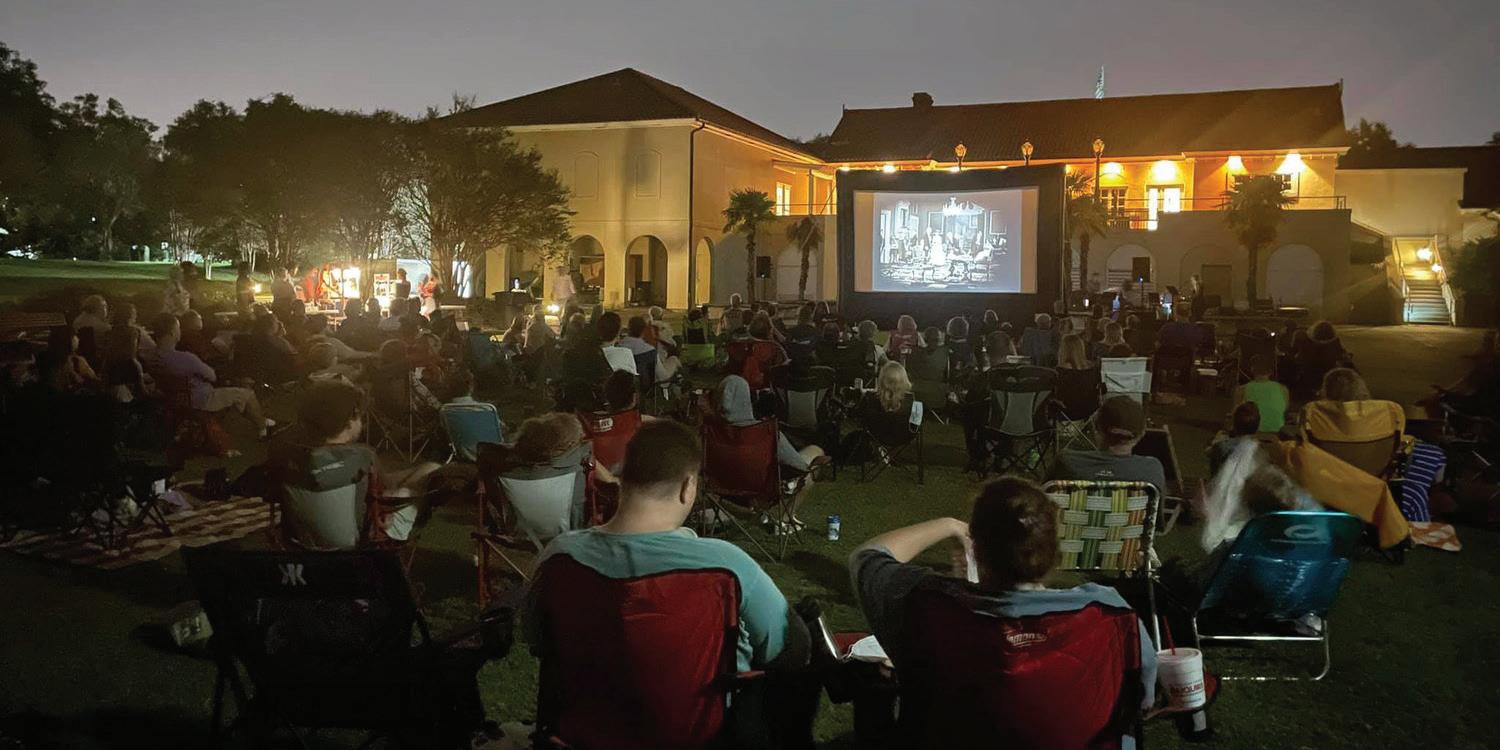
Bottomless popcorn and admission to one of the area’s most unique film series costs just $7. To make things even better, if you’re a BRG member, your admission is included in your membership! One of the region’s best brass bands, The Michael Foster Project, will be scor ing the silent movie “Sherlock Jr.” The show starts at 8 p.m. on Saturday, Oct. 8.
All I Really Need to Know I Learned in Kindergarten Music and Dramatic Arts Studio Theater
LSU Theatre presents “All I Really Need to Know I Learned in Kindergarten,” a play that takes a funny and heartwarming look at everyday life. Theatre performance senior Sam Staggs leads the fully student produced show, with performances on Thursday, Oct. 6, Friday, Oct. 7 and Sunday, Oct. 9 at 7:30 p.m. There is also a 2 p.m. matinee on Sunday, Oct. 9. Student tickets are $12. The Studio Theatre is located in the Music and Dramatic Arts building on campus.
8
Get ready for a lineup of pop punk, emo and indie rock bands at Mid City Ballroom, 136 S. Acadian Thruway. The show starts at 8 p.m. on Saturday, Oct. 8. Cover is $10.

The Legacy Dance Team is a group of diverse dancers from across the country at Louisiana State University.
Madison Cannon, an LSU politi cal communication major and pres ident of the dance team, said the Legacy Dancers are a performancebased, student run organization with the main goal of serving Black dancers in the Baton Rouge community.
“While the dance team is open to everyone, it gives Black danc ers a place to be showcased, espe cially at a public white institutional school,” Cannon said.
Legacy Dancers was founded by students in 2004 as an all-hip hop crew. Over time, it has progressed into a group of dancers that spe cialize in all genres of dance, in cluding hip-hop, jazz and contem porary. The dancers focus on good movement and performance qual ity, as well as confidence building.
Chloë Long, an LSU junior ma joring in biological sciences, serves as the Legacy Dancers’ social me dia manager. Long said a big part of the group’s mission is to share their love for dance with the Ba ton Rouge community with unique, family-oriented performances.
The team often performs at


the LSU and Southern University talent showcases and other local events around Baton Rouge. You can catch the Legacy Dancers’ next public performance at the Miss Phi Beta Sigma Pageant on Oct. 5.
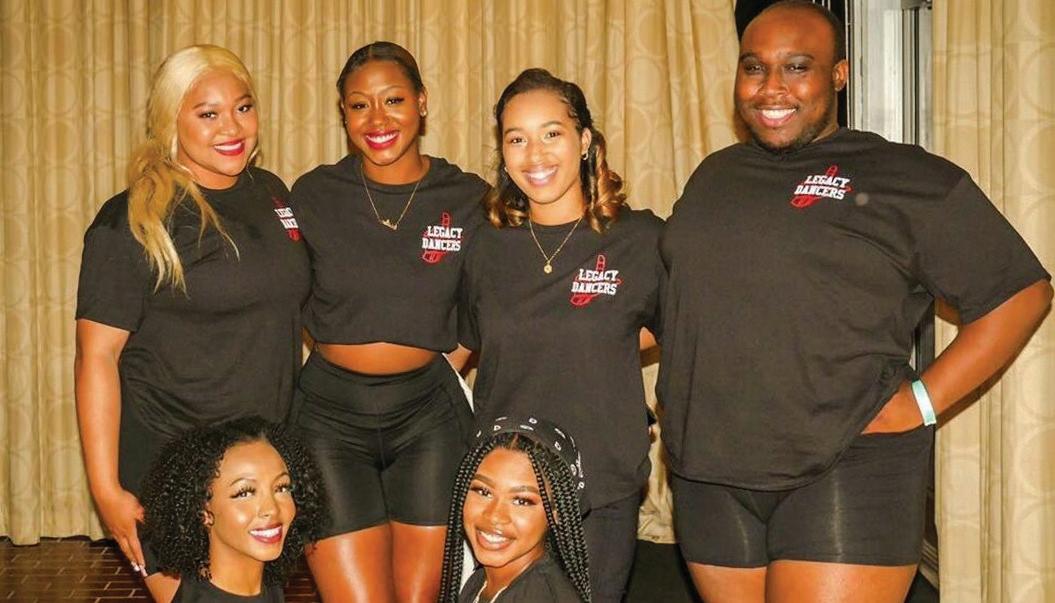
“The audience should expect a high energy jazz routine with lots of personality,” Long said. “This will be our first performance with our brand-new team.”
This could be considered a re building year for the Legacy Danc ers. After seniors graduated last May, the group only had four mem bers. Legacy Dancers has built its membership back up to 28.
Kaleb Clausell, an LSU sopho more majoring in kinesiology, is one of those members. She also serves as the team treasurer. Clau sell has been dancing since she was 2-years-old and enjoys con tinuing to perfect her craft at col lege at Legacy practices.
“In our practices, we normally perfect choreography if we have a performance coming up,” Clausell said. “But if not, then we treat it like a normal class and work on training and conditioning.”
The Legacy Dancers’ officer team plans to bring in guest chore ographers for future practices. The exposure of new moves and teach ing techniques challenges dancers, leaving room for improvement.
The club also aspires to introduce
A group of Legacy Dancers pose for a picture after performing at the Black Student Union competition in Spring 2022.
a majorette workshop sometime this fall.
The club’s officers encourage anyone who is passionate about dance and has basic technique skills to audition for Spring se mester membership at the end of January 2023. Practices are held on Fridays from 6 to 8 p.m.
The Legacy Dancers’ vice presi
dent, Shemaiah Verret, is an LSU junior majoring in elementary education and minoring in dance. Verret, who started dancing at age 14, encourages everyone to pursue their passions. It’s never too late to start, she said.
Legacy Dancers offer open workshops to dancers who are not on the team for $5. The team’s of

ficers recommend potential mem bers attend workshops, so they can be introduced to the team’s culture and get to know current members.
“If you have a passion for dance, come tryout,” Verret said. “We look forward to seeing you.”
You can find more information about the team on their social me dia @Legacy_Dancers.
For all the tigers with little cubs, the LSU AgCenter is hosting a family-friend ly corn maze on Oct. 8, 15, 22 and 29. Two-hour time slots are available from 9 a.m. to 4:30 p.m. each day. On Oct. 29, there is a special night maze from 6 p.m. to 9 p.m. In addition to the corn maze, there will also be local vendors, a pumpkin patch and hayrides. Tickets are only available online at Corn Maze at Burden (ticketspice.com) for $15 per person. The Corn Maze at Burden is lo cated at 4560 Essen Lane.
This pumpkin patch helps raise aware ness for breast cancer. There are two loca tions at the Baton Rouge General’s Mid-City campus, 3600 Florida Blvd. and the Blue bonnet campus, 8585 Picardy Ave. Dates have not yet been released since it’s a popup event, so be on the lookout during the month of October. Once the pink pumpkins pop up on the Baton Rouge General lawns, feel free to stop by, snap some selfies and bring a pumpkin home.










The Mortuary was built in 1872 and once served as an actual funeral home and crematori um for the city of New Orleans. It was converted into a haunted house in 2007. The Mortuary is celebrating its 150th anniversary this year with a new haunted house theme, “The House That Fear Built.” The Mortuary is located at 4800 Ca nal St., New Orleans.
About 45 minutes from Baton Rouge lies another frightening attraction, the RISE Haunted House, lo cated in Tickfaw at 10342, Hwy 442. RISE offers three separate haunting experiences: a traditional haunted house, a haunted hayride and the Risewell Asylum, an immersive and interactive experience where visitors may be touched. RISE is open every weekend in October.
Mrs. Heather’s Pumpkin Patch includes loads of fun farm activities and plenty of photo opportu nities. Pick your own pumpkin, wander through the corn and hay mazes and explore all the fam ily-friendly events offered. Admission is $9 per person. Mrs. Heather’s Pumpkin Patch is located at 11215 Lee’s Lane in Hammond.
Across the street from The 13th Gate, the Carnevil Haunted Midway has free concerts, nightly entertainment and haunted games. With actors roaming the streets in freaky costumes, prepare to be scared. This event is free and open during the month of October. Check The 13th Gate website for details on specific dates.
This Halloween, prepare to be scared. The 13th Gate Haunted House contains 13 truly terrifying realms where the lines between real life and horror are blurred. The 13th Gate has been recognized several times as one of the top haunted houses in the country. Fans of frights can buy tickets online starting at $35. The 13th Gate is located at 832 St. Philip St. and is open from 6:30 p.m. to 11:30 p.m. on select nights and every weekend in October.
Another family-friendly event this season is the Jefferson United Methodist Church Pumpkin Patch, located at 10328 Jeffer son Highway in Baton Rouge. This pump kin patch opens on Oct. 6 and will last throughout the month. It will be open on weekdays from 11 a.m. to 6 p.m.; Satur days from 9 a.m. to 6 p.m.; and Sundays from noon to 6 p.m.

Life as a musician doesn’t nec essarily mean packing up a tour bus and traveling to play gigs across the country. For some, it’s the passion to make music and primarily perform locally.
Allison Collins, a native of Prairieville, Louisiana, is a local musician through and through. She plays two gigs a week, most frequently at Superior Bar & Grill in Mid City and Sarita’s Grill & Cantina in Maurepas.

Collins discovered her tal ent at 10-years-old when singing along to “Greatest Love of All” by Whitney Houston. Her family al ways asked her to sing at gather ings. She started performing live for crowds at 18.
Collins didn’t originally plan to become a musician as a full-
time career. Collins attended LSU and received a bachelor’s degree in psychology with the inten tion of becoming a therapist. In the end, she decided to opt out of grad school and focus on her band.
“I felt I couldn’t breathe unless I was performing,” Collins said.









Collins created The Allison Collins Band in 2009. Over 10 years later, she’s still out perform ing today with The Allison Col lins Band, or The Allison Collins Trio, depending on the gig.
Collins mainly performs cov ers of songs, ranging from tunes from the ’60s to the present day. But she has dabbled in her own original music. As a huge Saints fan, Collins’ most popular song is “Imma Who Dat” which has over 75,000 views on YouTube.
Collins said that anything people can dance to, she’ll play.
As a mother of three and step mother of two, Collins under stands the importance of balanc ing work and personal life.
“Don’t drink, smoke or do drugs,” Collins said. “Exercise, eat right and take care of your self so that you will look and feel your best.”
While performing live is fun, Collins now uses her musical gifts to pay the bills and put food on the table. Despite her busy schedule, Collins takes time to enjoy life to the fullest and never forgets to appreciate the talents she was blessed with.
“Understand that if you have any kind of musical gift, it was given to you by God for a pur pose,” Collins said.
She hopes to continue cre ating music for all to enjoy and inspire other musicians to do the same.







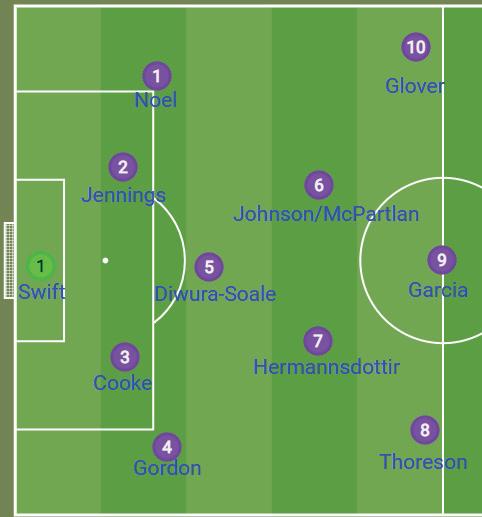 BY SPENCER VERRET @spencerverret
BY SPENCER VERRET @spencerverret
This season we’ve seen LSU Soccer Head Coach Sian Hudson use two main formations, the 4-33 and 3-5-2. These formations both have their uses to be called upon during games against differ ent opponents. Both formations provide different looks when in possession and out of possession. Let’s take a deep dive into the tac tics of LSU Soccer.
System of play: 4-3-3
Starting with the 4-3-3, this is the first formation we saw this year from Hudson. The set-up, as seen above, has mostly been unchanged from the start of the year. The goal of this formation is to maintain possession and get the ball forward. The key to this formation working and clicking is keeping balance on both sides of the pitch.
Seen more often in modern soccer is an attacking fullback. Rammie Noel is the perfect exam ple of this. On the team sheet and
roster website, she is listed as a forward and almost plays as such.
Take Alesia Garcia’s goal against Mississippi State for example, the goal starts with Noel receiving the ball in a deeper defensive role and working her way up the field. Af ter getting into a crossing position she sends the ball across and puts it on a platter for Garcia.
This type of attacking fullback play is what Hudson wants to see in the attack. But how does that maintain balance?
The answer is with Wasila
Diwura-Soale. Soale is a pivot or holding midfielder. She stays deeper than the rest of midfield and provides cover to the attack ing fullbacks. This cover provided also helps to maintain balance in the formation.
Out of possession, things get compact and tight. The back four tuck in to keep the strikers of the opposition out of the play. When possession reaches the defen sive third the fullbacks then can
LSU is full of talented athletes in a wide variety of sports, yet most go unnoticed by LSU stu dents and fans.
Many of those unnoticed ath letes are female athletes. These “wonder women” have helped LSU become one of the most dec orated athletic programs in the country.
Haleigh Bryant is one of those bright LSU athletes, and she has already reached one of the high est honors in her career. Return ing as a junior this year, Bryant was crowned the 2021 Vault Na tional Champion as a freshman.
She became the most decorat ed LSU freshman gymnast in the program, going on to become a 2021 SEC Freshman of the Year, 2021 WCGA Region 1 Gymnast of the Year and accumulating six to tal All-American honors. For Bry ant, being a star gymnast is noth ing new.
Bryant was born December 20, 2001, and grew up in Corne lius, North Carolina. She started gymnastics very young, and only played gymnastics growing up. Realizing very quickly the natural talent she had in the sport, Bry ant’s desire to pursue gymnastics only grew stronger.
Bryant was recruited to LSU as early as middle school, even com mitting to the Tigers in eighth grade. For her, moving to a school far from home was difficult, but the transition to LSU was smooth.
“I definitely think I had a pretty easy adjustment, especial ly coming to a team where I’ve
Tayvion Galloway was a much sought-after recruit for LSU to land to get a good start to its 2024 class. With his commitment in late July, Galloway contributed to a current third-ranked class for the Tigers in the Class of 2024.
Galloway is a 6-foot-5, 230 pound tight end from Chillicothe High School in Chillicothe, Ohio. He is ranked as the No. 4 tight end in the country, the No. 1 re cruit in Ohio and the No. 84 over all recruit in the country accord ing to the Top247sports rankings.
Galloway’s commitment isn’t
only important for overall talent, but because he extends LSU’s streak to three years in a row of landing a commitment from a four-star tight end, a position the Tigers are looking to add depth to.
Much, if not all, of the cred it for landing Galloway, goes to the new coaching staff. This new coaching staff has definitely con vinced players to buy into their system and philosophy, some thing the recruits seem to believe in.
Being from Ohio, Galloway was heavily recruited by the Uni versity of Cincinnati. Therefore, he had already had a connection
with Coach Mike Denbrock, who was previously the offensive co ordinator and tight ends coach at Cincinnati.
Galloway committed at a time when the new staff had not proved themselves at LSU yet, but he had enough trust in them to follow their lead.
“One of the biggest things was really the connection I’ve built with the staff,” Galloway said. “Just knowing my tight ends coach is Coach Denbrock, who I’ve been connecting with since UC [University of Cincinnati], and Coach BK [Brian Kelly] as my head coach just made it an easy choice to me.”
That connection Galloway made with Denbrock remained strong during the transition of Denbrock going from Cincinnati to LSU. But their relationship ex tends beyond football, as they both respect each other as peo ple away from their careers.
“Coach Denbrock is one of the most genuine guys I’ve met during my recruitment,” Gallo way said. “He’s shown a lot of love and at this point, I have a lot of faith in him.”
Galloway is a prime exam ple of the early impact the new coaching staff is making on the program. In order to “restart” a program, the staff has to recruit
aggressively and recruit the right players. For a player that is only just starting his junior season, and is from nowhere near the state of Louisiana, the new staff’s ability to recruit anywhere in the country has proven itself this summer in both the Classes of 2023 and 2024.
“They just have shown a lot of love and hospitality and that goes a long way with me when I can see it’s genuine,” Galloway said.
The new staff’s ability to con nect with players on a personal level has given them an advan tage, and the Tigers look to only strengthen their recruiting ability in the future.
stretch and try to win the ball.
In defense, the Tigers get com pact and try to force the opposi tion outside to win the ball and spark a counter attack. With the center back pairing of Shannon Cooke and Lindsi Jennings, the Tigers have been able to control most games at the back. The de fense has conceded 16 goals so far this season and an average of 10 shots per game.
It isn’t a great defensive record considering most teams in SEC play have conceded less than 10 goals so far. However, the defen sive record is strong enough to generate wins for the Tigers.
When the ball is won the goal is to counter-attack at speed. This has been seen plenty of times through Shannon Cooke. When she wins the ball at center back, she immediately looks up field for one of her forwards. Her ability to get the ball upfield easily can help pressure defenders into being out numbered, or be beaten by one of
the dynamic forwards.
LSU’s forward’s possesses have been amazing. The dribbling abil ity on show this year has been nothing short of spectacular. Not only that, but their runs off the ball have generated plenty of at tacking force for the offense. In attack, LSU prioritizes getting the ball to the wide areas of the field and outnumbering the wide de fenders to find time for a cross. This has been seen in many dif ferent combinations this year.
One area of the offense many people have noticed is Ida Her mannsdottir. Hermannsdottir cur rently is tied for the lead in goals this season with five. Hermanns dottir’s freshman campaign has been remarkable so far. She has shown she can score from dis tance, freekicks and good attack ing runs. She has proved to be a stellar attacking minded midfield er and will pay dividends for the Tigers for the rest of this season.
The offense has generated 31 goals on 166 shots this season. They average 13.833 shots per
game and 6.25 shots on target. Both are great averages to have.
The 4-3-3 has been the new look of Hudson’s team and at times can be seen as the future formation of the program. As the team spends more time in the for mation, they will become more relaxed and generate even better chances to be stronger defensively.
The kryptonite of LSU this sea son has been set pieces. Whether it be corner kicks, penalties, or free kicks, they have been rough at defending these. Against Mis sissippi State, they conceded two corner kicks in the first six min utes and then conceded a penalty later on.
LSU has conceded 51 corner kicks this season and five goals have been scored directly from those corners. That might not seem too terrible, but that’s not including corners where the ball might have been partially cleared and returned to the box for a goal.
Hudson has made it very clear that this is something that they
known these girls, we’ve all kind of adjusted together,” Bryant said.
“The heat, really, was one of the biggest things.”

Bryant also expressed her love for country music, similar to many LSU fans, including the famous “Callin’ Baton Rouge.”

Outside of gymnastics, she enjoys mostly socializing with her team mates, going out to movies and generally relaxing from the stress of Division 1 sports, but besides starring on the gym floor, Bryant is known for her character and personality.
“I think something I want ev eryone to know is that if anybody

needs anything, I’m always going to be somebody they can come talk to,” Bryant said. “I’m an open person, I’m not going to push anybody aside. I’m going to sup port everybody in whatever deci sion they make.”
Bryant as a student athlete has obviously shown her strengths in athletics, and as a kinesiology
will continue to look at and work at the training ground to figure out a good strategy for defending corners.
The other formation used during the season is the 3-5-2 as shown above. This formation was first seen against Central Florida in the second game of the season. It was deployed to counter the mid field possession shown by UCF in the first half. UCF was dominating the midfield and by deploying five midfielders, Hudson wanted to get more attacking bodies forward. It worked perfectly, LSU got a goal in the first five minutes of the sec ond half.
This formation brings bod ies forward that LSU is used to though. In the graphics shown, Noel is seen getting forward from her fullback role and can almost be seen as a midfielder. In a way, the 4-3-3 can easily be changed into the 3-5-2, that’s why this is the secondary formation. If Thore son drops back into a right mid fielder instead of right wing, they
major she has also shown how she excels in academics. She also shows her bright personality as a teammate. With the upcoming season set to begin this January, Bryant hinted at the team’s desire to perform.
“[I’m] just excited to show ev erybody what we’re working on and how hard we’re working and
then form a five in midfield.
The 3-5-2’s weaknesses can be exploited on the wings. When you have three center backs, the wide areas of the defensive third are left exposed if not covered by the wide midfielders. This can make the shape seem vulnerable to counter-attacks, but with how hard the wide midfielders work to get back, the shape is protected.
With this, most players con tinue to play the same role they would play in the 4-3-3. Noel is technically a wide midfielder, but she likes to get forward often from her fullback role creating that wide midfielder look. Her mannsdottir normally likes to play a sort of attacking midfielder role and this formation still allows for that. If the roles are identical, this makes changing the formation an easy halftime or mid-game switch.
Hudson has built a special foundation at LSU. When the time comes for the SEC tourney and the NCAA tournament, teams should be aware of the power LSU can bring.
it’s all going to pay off come Janu ary. There’s so much potential in this team and we’ve been work ing so hard,” Bryant said.
The Tigers are eager to show their talent on the big stages come January, and Bryant is equally ea ger to continue winning. As the season edges closer, Bryant will be one to watch on this LSU team.
L O C A L L Y D E S I G N E D & P R I N T E DIn 1981, President Ronald Rea gan made a choice that set the tone for decades of American labor at titudes.
When 12,000 members of the Professional Air Traffic Control lers Organization marched off the job that August after negotia tions broke down with the Federal Aviation Administration over their work contract, Reagan ordered them to return to work or be fired. As government union employees, their strike was illegal. Forty-eight hours later, Reagan made true on that threat and fired over 11,000 workers, permanently barring them from federal government work.
Such a harsh move would be hard for many other presidents to survive, but Reagan was incredibly popular.
“His policies may have been divisive, but his style wasn’t divi sive,” said political historian and LSU professor Bob Mann. “If you polled people on his policies, they may not be that popular… If you asked if they liked him, they’d say yes.”
Reagan’s popularity was the Trojan horse that allowed an army of anti-working class legislation through the gates.
The firing of those thousands of workers was a boon for the elite and set the tone for their encroach ments that have continued to this day. Critics of this argument try to diminish the importance of the PATCO firings by distinguishing between unions bargaining with the government versus with pri vate companies.
But this ignores the clear, in tended message sent by Reagan’s actions. He let every employer in America know his administration’s view of labor rights. The firing of the air traffic controllers was the symbolic lynchpin and a harbinger of the coming gains for the prince at the expense of the pauper.
An ideal government protects its people from the predation of big business. This country’s cur rent reality is a demonstration of what happens when government and business join forces against labor.
Productivity has increased in the past few decades, but that isn’t evident looking at wages. From
1979 to 2020, productivity has outpaced pay by a factor of 3.5, according to the Economic Policy Institute.
From 1983 to 2021 the percent age of workers that are part of a union has fallen from 20% to 10%, according to the Pew Research cen ter. This trend is no random occur rence, but rather the result of de liberate suppression of labor by the ruling class.
Professional consulting firms are a great resource for compa nies to crush union activity. Ama zon, for one, contracted the Burke Group, a labor relations consulting firm, to help the company squash the union vote at a facility in Bes semer, Alabama.
The campaign involved send ing texts and mail to employees warning them about the supposed dangers of joining a union. Ama zon even offered bonuses to em ployees who quit before the elec tion according to local reporting by AL.com.
Employers fear unions — they shudder to think of a dark future where their employees make a liv ing wage and get paid time off. With elected officials often in the
pockets of corporations, unions are the only avenue for workers to have a seat at the table.
Unionized workers earn 11% more in wages than their nonunionized counterparts, according to the Economic Policy Institute. Even non-unionized workers bene fit from high union density in their state. States with higher union density have higher wages even for non-unionized workers. When forced to compete with union jobs, employers must offer more to their workers.
Unionized workers are 18% more likely to receive health insur ance from their employer, accord ing to a Congressional committee report. Employers also pay 77% more per hour worked toward the cost of health insurance for union ized workers compared with nonunionized workers, the report found.
When workers stand together, they hold unique strength to advo cate for themselves and their work ing conditions.
“As individuals, we have very little recourse against those who would take advantage of our la bor,” said Jack Griswold, a student
senator from the LSU College of Humanities and Social Sciences and the chairperson of the Senate committee on Student Auxiliary Services. “The union, as an entity, unites our minds and resources against such an abuser, or better, serves as a deterrent against such a threat. Without such organizations, the fair and productive workplace would be rare.”
Labor unions have also helped decrease racial and gender pay gaps. This effect of unions is the material manifestation of the ten dency unions have to bring people together.
“The bosses want you divided among race, gender and politics,” said Adam Dohrenwend, a geogra phy and anthropology grad student who, heads the Grad Gold Student Government ticket and is a mem ber of the United Campus Workers of Louisiana. “We’re more similar than we are different. Unions are a fundamental way of society to real ize that.”

The idea of division is central to the corporate goal of prevent ing collective bargaining. People in power purposely sow discord among the working class through
the media, a kind of cultural union busting that aims to prevent class consciousness and worker solidar ity.
The media will pay lip service to stories about the illegal laborcrushing actions of corporations or rising pro-union sentiment. How ever, most of their news is an ongo ing debate centered around what ever Fox News or CNN decided to get upset about in a given week. These news stories ensure that people are directing their ire at their neighbor and not their boss.
The assault on labor has been deliberate and corrosive to the lives of everyday Americans. In the same country where people are starving, billionaires are spending their money trying to get to space for no discernible reason.
The American worker is suffer ing, and the problem, unfortunate ly, can’t be fixed by asking nicely. The only viable means of taking back what’s been lost is through the powerful unionization of the labor force.
Frank Kidd is a 21-year-old mass communication junior from Springfield, Virginia.
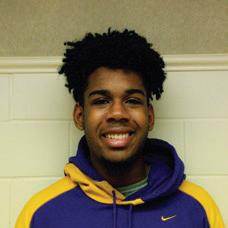
The Reveille (USPS 145-800) is written, edited and produced solely by students of Louisiana State University. The Reveille is an independent entity of the Office of Student Media within the Manship School of Mass Commu nication. Signed opinions are those of the author and do not necessarily represent the views of the editor, The Reveille or the university. Letters submitted for publication should be sent via e-mail to editor@lsu.edu or deliv ered to B-39 Hodges Hall. They must be 400 words or less. Letters must provide a contact phone number for ver ification purposes, which will not be printed. The Reveille reserves the right to edit letters and guest columns for space consideration while preserving the original intent. The Reveille also reserves the right to reject any letter without notification of the author. Writers must include their full names and phone numbers. The Reveille’s edi tor in chief, hired every semester by the LSU Student Media Board, has final authority on all editorial decisions.
“Life, it turns out, is infinitely more clever and adaptable than anyone had ever supposed.”
Arthur Conan Doyle Scottish writer TAYLOR HAMILTON @taylorhami04
TAYLOR HAMILTON @taylorhami04
College students, rushing from class to class, get plenty of steps in on LSU’s sprawling campus. Nevertheless, walking shouldn’t be a student’s only form of exercise.
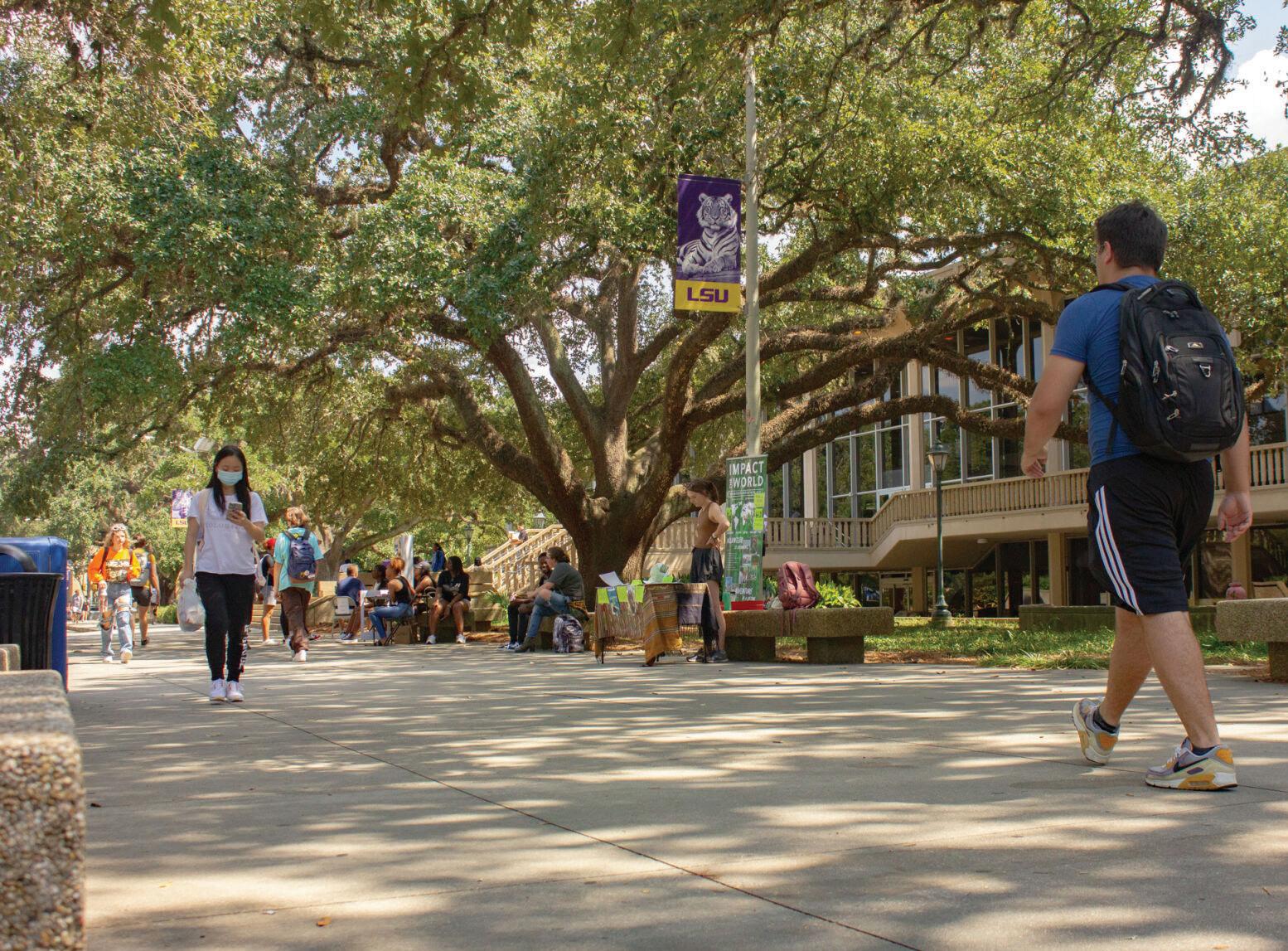
According to the Better Health Channel, some benefits of exercising include lowering cholesterol, reducing your risk of a heart attack and lowering your risk of diabetes. Exercise also can uplift your mood and distract you from your daily worries.
Whenever I have a challeng ing day, I enjoy going to the University Recreation Center for half-an-hour and running on the treadmill or climbing the stairs. That short, 30-minute time frame allows me to relax and fo cus on exercising rather than on an essay or an exam.
Although walking can be great exercise, especially when trekking over 3 miles daily, walking only uses specific mus cles within the body, including your hamstrings, back muscles and quadriceps. To stay healthy, going to the UREC is the perfect
option to work on other muscles to increase strength and balance.
John Nickerson, the UREC’s associate director of marketing,
assessment and communication, said that research shows that ex ercise releases a chemical called brain-derived neurotrophic fac

tor, which is linked to better memory and information reten tion.
“So by releasing that BDNF,
you’re going to have better study habits and higher grades in the classroom,” Nickerson said. “And really, that only takes 20-40 min utes of getting your heart rate up in a more intense workout.”
The UREC is one of the best perks of being an LSU student. It has a rock-climbing wall, stan dard gym equipment, two swim ming pools, yoga and cycling classes, basketball courts, rac quetball and much more.
All full-time students have free access to the UREC, so there’s no excuse for students not to go at least once a week. Whether students want to work out by themselves or with friends, the UREC is a great place to listen to music while releasing any pressure from the week.
The UREC doesn’t pressure students to lift weights like there’s no tomorrow. It’s a lowpressure environment where students can work out and grab a smoothie afterwards. All it takes is 30 minutes of your day to focus on yourself and your health, because at the end of the day, you have to look out for your well-being.
Taylor Hamilton is an 18-yearold mass communication fresh man from Tallahassee, Florida.
Group
04 Health Professions
07
Interviewing
a.m.–4:30